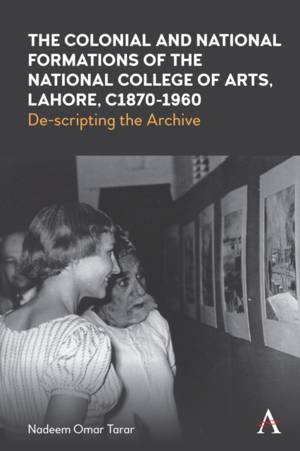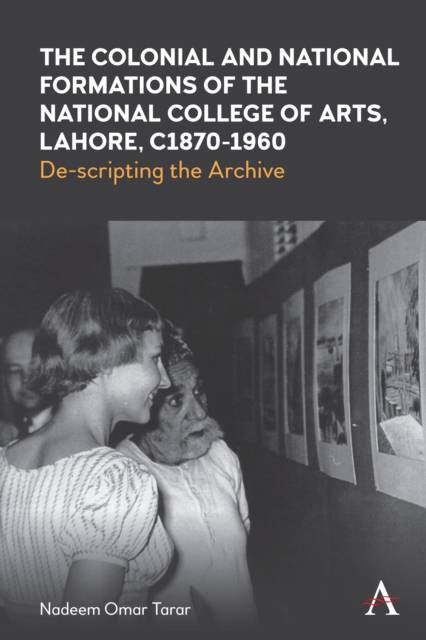
En raison d'une grêve chez bpost, votre commande pourrait être retardée. Vous avez besoin d’un livre rapidement ? Nos magasins vous accueillent à bras ouverts !
- Retrait gratuit dans votre magasin Club
- 7.000.000 titres dans notre catalogue
- Payer en toute sécurité
- Toujours un magasin près de chez vous
En raison de la grêve chez bpost, votre commande pourrait être retardée. Vous avez besoin d’un livre rapidement ? Nos magasins vous accueillent à bras ouverts !
- Retrait gratuit dans votre magasin Club
- 7.000.0000 titres dans notre catalogue
- Payer en toute sécurité
- Toujours un magasin près de chez vous
The Colonial and National Formations of the National College of Arts, Lahore, Circa 1870s to 1960s
Nadeem Omar Tarar
201,45 €
+ 402 points
Description
Drawing on archival sources, this book provides an anthropological exploration of the National College of Arts (NCA) in Lahore, tracing its evolution from the Mayo School of Arts established in 1875. As a counterpart to London's South Kensington School of Design (now the Royal College of Art), the Mayo School emerged as a crucial site for the dissemination of colonial art education in British India, alongside similar institutions in Calcutta, Bombay, and Madras. Named to honor Lord Earl of Mayo, the only Viceroy of India assassinated in office, it was founded by Lockwood Kipling and featured a distinguished roster of educators including Ram Singh, Percy Brown, Lionel Heath, S.N. Gupta, B.C. Sanyal, and A.R. Chughtai. The Mayo School also initiated the Journal of Indian Art and Industry, a seminal publication utilizing cutting-edge chromolithography techniques. The book employs theoretical analysis to understand how the NCA, functioning as a bureaucratic entity, has shaped the landscape of design education, museums, and artistic practices in both colonial and postcolonial contexts. From its roots in British art education, derived from South Kensington, the institution's trajectory reflects its adaptation through American reforms in the early years of Pakistani independence. This analysis critically examines how frameworks of art history and anthropology have been mobilized to construct and objectify Pakistani art and artists. Furthermore, the book explores the contributions of colonial anthropologists such as Richard Temple, Denzil Ibbetson, and Baden Powell, who were instrumental in the establishment and administration of the Mayo School. Their work in ethnographic reconstruction provided a cultural framework that influenced the education of artisan castes, situating them within a "primitive" Punjabi context. This colonial subtext profoundly impacted the pedagogical approaches of the Mayo School, which also nurtured the emergence of the Indo-Saracenic architectural style and supported traditional Punjabi painting. Despite its industrial art orientation, the Mayo School was pivotal in the development of a modern Punjab painting tradition recognized at the British Indian Empire Exhibition of 1924. Under the guidance of Lionel Heath, the school began to embrace modern art, with printmaking, graphic design, and sculpture taking root in the 1930s through the efforts of B.C. Sanyal and M.M. Hussain. The Mayo School's printing press produced a diverse array of materials, reflecting major Western art movements from Arts and Crafts to Art Deco and Bauhaus. In the formative years of Pakistan, the Mayo School transitioned into the National College of Arts in 1958, modeled after the Bauhaus with departments in Fine Art, Design, and Architecture. Influential figures such as poet Faiz Ahmed Faiz, painter Shakir Ali, art patron Ghulam Mueenuddin, and American sculptor Mark Sponenburgh were pivotal in shaping the NCA as Pakistan's premier institution for art and design. Through a critical examination of art history and anthropological frameworks, this book elucidates how imperial and nationalist discourses have intersected to shape and redefine artistic and cultural identities within Pakistan.
Spécifications
Parties prenantes
- Auteur(s) :
- Editeur:
Contenu
- Nombre de pages :
- 256
- Langue:
- Anglais
- Collection :
Caractéristiques
- EAN:
- 9781785277924
- Date de parution :
- 08-02-22
- Format:
- Livre relié
- Format numérique:
- Genaaid
- Dimensions :
- 231 mm x 155 mm
- Poids :
- 521 g

Les avis
Nous publions uniquement les avis qui respectent les conditions requises. Consultez nos conditions pour les avis.






